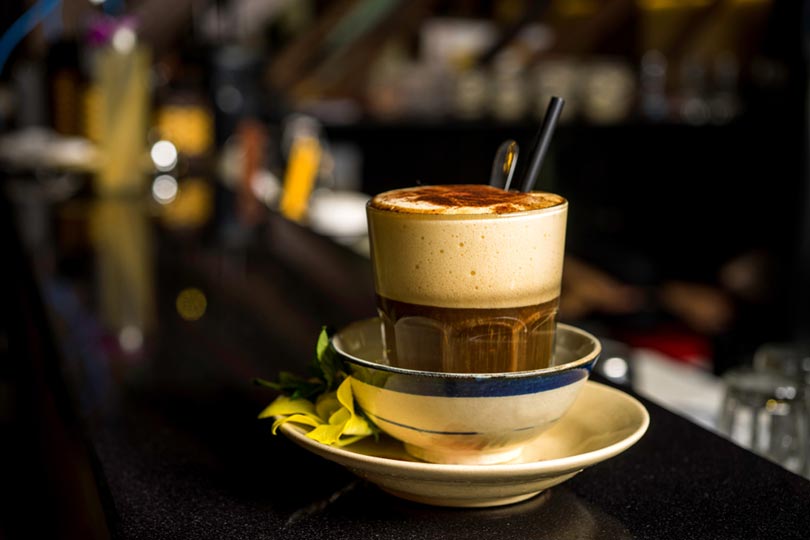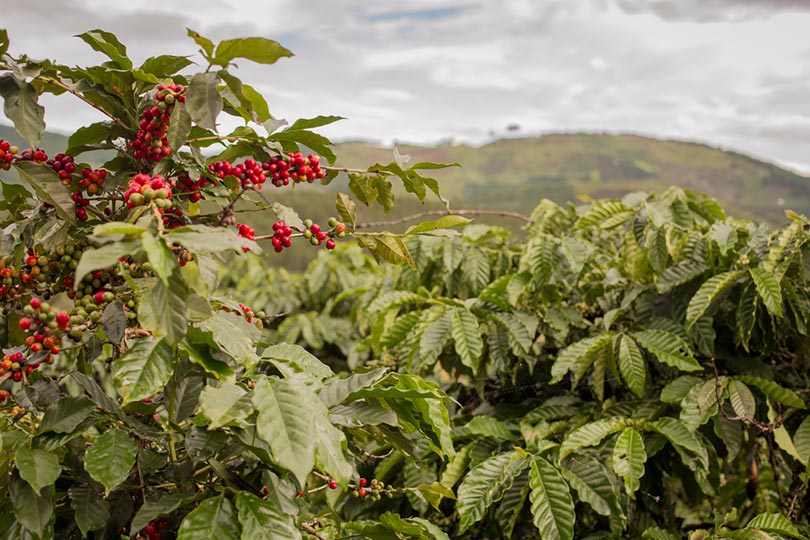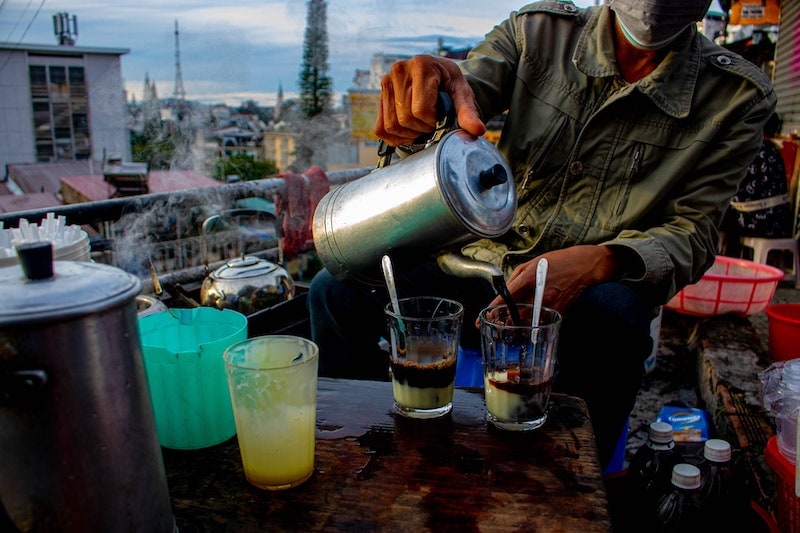
Visitors to Vietnam know about its beautiful beaches, diverse cities, and ancient temples. But if you are not looking for it, you might miss the hidden gem of Vietnamese Coffee Culture. Vietnam’s highlands produce more coffee than any other country except Brazil, and its people have their own local culture that is like nowhere else. Although you can find an American-style coffee to pick you up in the morning, if you have the time to sit down and explore the local styles, you will have an unforgettable experience.

Vietnamese Coffee History
Coffee was first domesticated in Ethiopia and did not make its way to Vietnam until the 19th century when French colonizers brought the drink with them. But coffee soon became a major crop in Vietnam, and the Vietnamese people fell in love with the rich flavors of their local coffee. Two factors have left an indelible mark on Vietnam’s coffee culture—the French influence and the growth of coffee agriculture in the Vietnamese Highlands.

The French Touch on Vietnam’s Coffee
France began colonizing Vietnam in the 1850s, with their influence lasting into the mid-1950s. This long colonial influence is still felt in their coffee culture today. One of the most noticeable effects of this influence is the use of a French-style drip filter to make coffee. This filter creates a rich, flavorful blend that stands distinct from American coffees.
Another effect of colonization is the Vietnamese sweet tooth. Because of the difficulty of obtaining cow’s milk in 19th century Vietnam, sweetened condensed milk became the substitute of choice. Although you can find bitter, dark coffee blends, many of Vietnam’s traditional recipes use sweet, syrupy condensed milk to balance out the bitterness of their coffee.
Vietnam’s Growing Coffee Market
Coffee requires a particular set of conditions to grow. The best growing conditions are at a high elevation—2,000 to 4,000 feet above sea level. But they also need a frost-free climate, without the harsh winters that most highlands face. Because of these conditions, only a small band of latitude near the equator is suitable for coffee-growing. Vietnam’s highlands are the perfect choice and there are pockets of land all over the country that have the ideal elevation, rainfall, temperature, and soil. Vietnam has grown coffee since the 1900s, but coffee production really took off in the 1980s and 1990s, and it’s been trending upwards ever since.

Arabica vs Robusta Beans: The Secret to Vietnam’s Rich Flavors
Just like so many other crops, there are many different cultivars of coffee beans, and one of them holds the biggest key to Vietnamese-style coffee. The most common cultivar sold in the United States is the Arabica bean. This type of bean is produced in many regions in the northern half of Vietnam. But Vietnam’s real darling is the Robusta bean. Robusta beans are known for their strength and flavor, but in the United States, they are mainly used in coffee blends. They pack a punch, with about double the caffeine content of Arabica beans, and have a strong, rich flavor that is a little more bitter than Arabica. Robusta beans are sometimes called the dark chocolate to Arabica’s milk. You might want to add a little more sugar than normal to cut the edge down, but don’t discount Robusta beans too quickly. There’s a depth of flavor here that you won’t find in your local Starbucks.

Vietnam’s Unique Coffee Styles
Although you can ask for a cappuccino or a macchiato in most Vietnamese coffee shops, Vietnam also has its own local favorites. Most Vietnamese coffee is iced and heavily sweetened. Here are some of the unique styles popular in Vietnam.

Ca phe Hanoi
Ca phe Hanoi (Hanoi-style coffee) is most popular in the north of Vietnam. This is a short, strong coffee with a thick consistency. It’s often served with green tea to cleanse your palate in between sips. Northern Vietnam is known for its slower pace of life, and the coffee matches. This is definitely a coffee to be savored!
Ca phe Saigon
Ca phe Saigon (Saigon or Ho Chi Minh City Style coffee) is better known in the urban south. This is a long coffee served with a straw, the better to suit a busy lifestyle. If you ask for a coffee without specifying the type in Southern Vietnam, this is what you’re most likely to get.
Egg Coffee

One unique coffee treat is Vietnamese Egg Coffee. Invented in the 1940s in Hanoi, this coffee has become an iconic part of local culture. It’s made by whisking egg yolks and condensed milk into a rich, frothy foam before adding coffee. The result is a decadent (and photogenic) sweet treat.
Bac Xiu (White Coffee)

This style of coffee comes from a cultural fusion of Chinese and Vietnamese tastes. Unlike most Vietnamese coffees, it’s often served hot. Bạc Xỉu is a super-sweet milk coffee with a rich, custardy flavor. It has the advantage of a much lower caffeine content, but on the other hand its sticky sweetness might be too much for many.
Coffee Yogurt and Smoothies
In Vietnam’s tropical areas, coffee yogurts and smoothies are a popular but unexpected combination. These usually have a blend of yogurt, coffee, and fruit. The end result is delicious, creamy, and a little tangy—perfect for cooling off after a hot day. This is another great choice if you’re trying to keep your caffeine intake down.
Coconut Coffee

Another tropical drink that’s popular with visitors to Vietnam is coconut coffee. Sweet, delicious coconut cream is whipped and used to top iced coffee, providing a novel and delicious flavor pairing. Sweetened condensed milk is often used in this coffee too, but if you eat dairy free many cafés can leave it out and go all in on the coconut.
Coffee Shops and Street Cafés: Where and How to Order
Big chain coffee shops aren’t nearly as popular in Vietnam as the United States. Here, local shops dominate. Traditionally, coffee is served in picturesque street cafés, where you can enjoy the fresh air as you sip on your drink. However, indoor coffee shops are becoming increasingly common as well. These shops look a little more familiar to Western eyes, but they’ll still give you a chance to taste Vietnamese-style coffee.
When you visit a Vietnamese café, the “standard” coffee is a little different from what you’d expect. If you like your coffee hot and bitter, you’ll have to specify. Most of the time, Vietnamese coffee shops default to an iced coffee with plenty of sugar. They’ll also generally use a drip filter, and they might use sweetened condensed milk instead of standard milk. Finally, expect them to use Robusta beans unless they advertise both types.

Last Thoughts
Whether you’re going to Vietnam for a relaxing stay at a beach resort or an exciting adventure through the country’s mountainous center, travel will give you unique opportunities to explore a new culture. And while many have a long list of Vietnamese foods to try, few think to try the local coffees. If you love a morning cuppa and have an adventurous taste, you can’t miss the chance to try out the local Vietnamese coffee culture for yourself.
- https://www.tourhero.com/en/magazine/gastronomy/coffee-in-vietnam-a-way-of-life/
- https://www.exoticvoyages.com/blog/a-guide-to-vietnamese-coffee-35456.html
- https://helloteacup.com/2020/12/15/vietnam-coffee-culture/
- https://halo.coffee/blogs/discover/coffee-regions-a-quick-guide-to-coffee-growing-regions
- https://deliciousvietnam.net/vietnamese-super-sweet-milk-coffee-bac-xiu/
Featured Image Credit: ngoc tran, Shutterstock
















